Numerical Investigation of the Effect of Supersonic Air Temperature on the Mixing Characteristics of Liquid Fuel
Abstract
1. Introduction
2. Mathematical Formulation and Numerical Simulation
2.1. Model Geometry and Physical Parameter
2.2. Numerical Simulation
2.3. Mathematical Modeling
2.3.1. Eulerian Governing Equations
2.3.2. Lagrangian Model for Fuel Droplet Tracking
2.3.3. Droplet Breakup Model
2.3.4. Mesh Independent Study and Solution Validation
3. Simulation Results and Discussion
3.1. Streamwise Vortex
3.2. Mixing Efficiency
3.3. Total Pressure Loss
4. Conclusions
- (1)
- The higher the air temperature, the stronger the magnitude of the streamwise vortices downstream of the pylon. The streamwise vortices adjacent to the pylon became stronger as it moved away from the pylon, but after X/d = 140.6, the influence of the alternating-wedge of the pylon decreased and the streamwise vortices gradually weakened toward the downstream of the pylon.
- (2)
- When the air temperature was 373 K, the liquid fuel hardly evaporated, but as the air temperature was higher than the fuel boiling point (460 K), the mixing efficiency increased linearly downstream of the pylon. At air temperatures of 523 K and 673 K, the mixing efficiencies were 10% and 51% at the combustor outlet (X/d = 703), respectively.
- (3)
- The total pressure loss decreased slightly as the temperature increased from 373 K to 673 K, and the decrease was larger toward the downstream of the pylon. The total pressure loss at the combustor outlet was 20.9% at air temperature of 373 K and 19.4% at 673 K. This appears to be caused by the presence of smaller and fewer fuel droplets as the temperature increases.
Author Contributions
Funding
Data Availability Statement
Conflicts of Interest
References
- Curran, E.T. Scramjet engines: The first forty years. J. Propuls. Power 2001, 17, 1138–1148. [Google Scholar] [CrossRef]
- Li, Z.; Gu, H. Investigation for effects of jet scale on flame stabilization in scramjet combustor. Energies 2022, 15, 3790. [Google Scholar] [CrossRef]
- Fry, R.S. A century of ramjet propulsion technology evolution. J. Propuls. Power 2004, 20, 27–58. [Google Scholar] [CrossRef]
- Jeong, S.-M.; Choi, J.-Y. Combined diagnostic analysis of dynamic combustion characteristics in a scramjet engine. Energies 2020, 13, 4029. [Google Scholar] [CrossRef]
- Relangi, N.; Ingenito, A.; Jeyakumar, S. The implication of injection locations in an axisymmetric cavity-based scramjet combustor. Energies 2021, 14, 2626. [Google Scholar] [CrossRef]
- Li, F.; Sun, M.; Cai, Z.; Chen, Y.; Sun, Y.; Li, F.; Zhu, J. Effects of additional cavity floor injection on the ignition and combustion processes in a Mach 2 supersonic flow. Energies 2020, 13, 4801. [Google Scholar] [CrossRef]
- Choubey, G.; Devarajan, Y.; Huang, W.; Mehar, K.; Tiwari, M.; Pandey, K.M. Recent advances in cavity-based scramjet engine- a brief review. Int. J. Hydrog. Energy 2019, 44, 13895–13909. [Google Scholar] [CrossRef]
- Kim, C.-H.; Jeung, I.-S. Forced combustion characteristics related to different injection locations in unheated supersonic flow. Energies 2019, 12, 1746. [Google Scholar] [CrossRef]
- Jeong, E.; O’Byrne, S.; Jeung, I.-S.; Houwing, A.F.P. The effect of fuel injection location on supersonic hydrogen combustion in a cavity-based model scramjet combustor. Energies 2020, 13, 193. [Google Scholar] [CrossRef]
- Athithan, A.A.; Jeyakumar, S.; Sczygiol, N.; Urbanski, M.; Hariharasudan, A. The combustion characteristics of double ramps in a strut-based scramjet combustor. Energies 2021, 14, 831. [Google Scholar] [CrossRef]
- Lewis, M.J. Significance of fuel selection for hypersonic vehicle range. J. Propuls. Power 2001, 17, 1214–1221. [Google Scholar] [CrossRef]
- Denman, Z.J.; Wheatley, V.; Smart, M.K.; Veeraragavan, A. Fuel injection and mixing in a Mach 8 hydrocarbon-fuelled scramjet. In Proceedings of the 20th Australasian Fluid Mechanics Conference (AFMC 2016), Perth, Australia, 5–8 December 2016. [Google Scholar]
- Zhang, J.; Chang, J.; Shi, W.; Hou, W.; Bao, W. Combustion stabilizations in a liquid kerosene fueled supersonic combustor equipped with an integrated pilot strut. Aerosp. Sci. Technol. 2018, 77, 83–91. [Google Scholar] [CrossRef]
- Powell, O.A.; Edwards, J.T.; Norris, R.B.; Numbers, K.E.; Pearce, J.A. Development of hydrocarbon-fueled scramjet engines: The hypersonic technology (HyTech) program. J. Propuls. Power 2001, 17, 1170–1176. [Google Scholar] [CrossRef]
- Hunt, J.L.; Rausch, V.L. Airbreathing hypersonic systems focus at NASA Langley research center. In Proceedings of the 8th AIAA International Space Planes and Hypersonic Systems and Technologies Conference, Norfolk, VA, USA, 27–30 April 1998. AIAA Paper 98-1641. [Google Scholar]
- Papamoschou, D.; Roshko, A. The compressible turbulent shear layer: An experimental study. J. Fluid Mech. 1988, 197, 453–477. [Google Scholar] [CrossRef]
- Ren, Z.; Wang, B.; Xiang, G.; Zhao, D.; Zheng, L. Supersonic spray combustion subject to scramjets: Progress and challenges. Prog. Aerosp. Sci. 2019, 105, 40–59. [Google Scholar] [CrossRef]
- Hartfield, R.J.; Hollo, S.D.; McDaniel, J.C. Experimental investigation of a supersonic swept ramp injector using laser-induced iodine fluorescence. J. Propuls. Power 1994, 10, 129–135. [Google Scholar] [CrossRef]
- Rogers, R.C.; Capriotti, D.P.; Guy, R.W. Experimental supersonic combustion research at NASA Langley. In Proceedings of the 20th AIAA Advanced Measurement and Ground Testing Technology Conference, Albuquerque, NM, USA, 15–18 June 1998. AIAA Paper 98-2506. [Google Scholar]
- Gruenig, C.; Avrashkov, V.; Mayinger, F. Fuel injection into a supersonic airflow by means of pylons. J. Propuls. Power 2000, 16, 29–34. [Google Scholar] [CrossRef]
- Bogdanoff, D.W. Advanced injection and mixing techniques for scramjet combustors. J. Propuls. Power 1994, 10, 183–190. [Google Scholar] [CrossRef]
- Sunami, T.; Magre, P.; Bresson, A.; Grisch, F.; Orain, M.; Kodera, M. Experimental study of strut injectors in a supersonic combustor using OH-PLIF. In Proceedings of the AIAA/CIRA 13th International Space Planes and Hypersonics Systems and Technologies Conference, Capua, Italy, 16–20 May 2005. AIAA Paper 2005-3304. [Google Scholar]
- Vergine, F.; Ground, C.; Maddalena, L. Strut injectors for scramjets: Total pressure losses in two streamwise vortex interactions. J. Propuls. Power 2017, 33, 1140–1150. [Google Scholar] [CrossRef]
- Hwang, B.-J.; Min, S. Research progress on mixing enhancement using streamwise vortices in supersonic flows. Acta Astronaut. 2022, 200, 11–32. [Google Scholar] [CrossRef]
- Seiner, J.M.; Dash, S.M.; Kenzakowski, D.C. Historical survey of enhanced mixing in scramjet engines. J. Propuls. Power 2001, 17, 1273–1286. [Google Scholar] [CrossRef]
- Huang, W.; Du, Z.-B.; Yan, L.; Xia, Z.-X. Supersonic mixing in airbreathing propulsion systems for hypersonic flights. Prog. Aerosp. Sci. 2019, 109, 100545. [Google Scholar] [CrossRef]
- Curran, E.T.; Heiser, W.H.; Pratt, D.T. Fluid phenomena in scramjet combustion systems. Annu. Rev. Fluid Mech. 1996, 28, 323–360. [Google Scholar] [CrossRef]
- Doster, J.C.; King, P.I.; Gruber, M.R.; Maple, R.C. Pylon fuel injector design for a scramjet combustor. In Proceedings of the 43rd AIAA/ASME/SAE/ASEE Joint Propulsion Conference and Exhibit, Cincinnati, OH, USA, 8–11 July 2007. AIAA Paper 2007-5404. [Google Scholar]
- Doster, J.C.; King, P.I.; Gruber, M.R.; Carter, C.D.; Ryan, M.D.; Hsu, K.-Y. In-stream hypermixer fueling pylons in supersonic flow. J. Propuls. Power 2009, 25, 885–901. [Google Scholar] [CrossRef]
- Manna, P.; Behera, R.; Chakraborty, D. Liquid-fueled strut-based scramjet combustor design: A computational fluid dynamics approach. J. Propuls. Power 2008, 24, 274–281. [Google Scholar] [CrossRef]
- Kumaran, K.; Behera, P.R.; Babu, V. Numerical investigation of the supersonic combustion of kerosene in a strut-based combustor. J. Propuls. Power 2010, 26, 1084–1091. [Google Scholar] [CrossRef]
- Dharavath, M.; Manna, P.; Sinha, P.K.; Chakraborty, D. Numerical Analysis of a Kerosene-Fueled Scramjet Combustor. ASME J. Therm. Sci. Eng. Appl. 2016, 8, 011003. [Google Scholar] [CrossRef]
- Hwang, B.-J.; Choi, H.; Min, S. An experimental study on penetration and mixing characteristics of liquid fuel in preheated supersonic airflows. Acta Astronaut. 2023, 202, 511–521. [Google Scholar] [CrossRef]
- Hiejima, T. Theoretical analysis of streamwise vortex circulation induced by a strut injector. Phys. Rev. Fluids 2016, 1, 054501. [Google Scholar] [CrossRef]
- Bruno, T.J.; Huber, M.L.; Laesecke, A.; Lemmon, E.W.; Perkins, R.A. Thermochemical and Thermophysical Properties of JP-10 (NISTIR 6640); National Institute of Standards and Technology: Gaithersburg, MD, USA, 2006; pp. 14–25. [Google Scholar]
- Hwang, B.-J.; Kang, S.; Lee, H.J.; Min, S. Measurement of laminar burning velocity of high performance alternative aviation fuels. Fuel 2020, 261, 116466. [Google Scholar] [CrossRef]
- No, S.-Y. A review on empirical correlations for jet/spray trajectory of liquid jet in uniform cross flow. Int. J. Spr. Combust. Dyn. 2015, 7, 283–314. [Google Scholar] [CrossRef]
- Menter, F.R. Two-equation eddy-viscosity turbulence models for engineering applications. AIAA J. 1994, 32, 1598–1605. [Google Scholar] [CrossRef]
- Li, L.-Q.; Huang, W.; Fang, M.; Shi, Y.-L.; Li, Z.-H.; Peng, A.-P. Investigation on three mixing enhancement strategies in transverse gaseous injection flow fields: A numerical study. Int. J. Heat Mass Transf. 2019, 132, 484–497. [Google Scholar] [CrossRef]
- ANSYS. ANSYS Fluent Theory Guide; ANSYS Inc.: Canonsburg, PA, USA, 2013; pp. 2–600. [Google Scholar]
- Liu, A.B.; Mather, D.; Reitz, R.D. Modeling the effects of drop drag and breakup on fuel sprays. In Proceedings of the 1993 SAE International Congress and Exposition, Detroit, MI, USA, 1–5 March 1993. SAE Technical Paper 930072. [Google Scholar]
- Beale, J.C.; Reitz, R.D. Modeling spray atomization with the Kelvin-Helmholtz/Rayleigh-Taylor hybrid model. At. Sprays 1999, 9, 623–650. [Google Scholar] [CrossRef]
- Li, X.; Soteriou, M.C. Detailed numerical simulation of liquid jet atomization in crossflow of increasing density. Int. J. Multiph. Flow 2018, 104, 214–232. [Google Scholar] [CrossRef]
- Barth, T.J.; Jespersen, D.C. The design and application of upwind schemes on unstructured meshes. In Proceedings of the 27th Aerospace Sciences Meeting, Reno, NV, USA, 9–12 January 1989. AIAA Paper 89-0366. [Google Scholar]
- Rausch, R.D.; Batina, J.T.; Yang, H.T.Y. Spatial adaptation of unstructured meshes for unsteady aerodynamic flow computations. AIAA J. 1992, 30, 1243–1251. [Google Scholar] [CrossRef]
- Liou, M.-S.; Steffen, C.J. A new flux splitting scheme. J. Comput. Phys. 1993, 107, 23–39. [Google Scholar] [CrossRef]
- ANSYS. ANSYS Fluent Users Guide; ANSYS Inc.: Canonsburg, PA, USA, 2013; pp. 289–292. [Google Scholar]
- Hinze, J.O. Turbulence, 2nd ed.; McGraw-Hill Book Co.: New York, NY, USA, 1975; pp. 1–82. [Google Scholar]
- Chen, X.-Q.; Pereira, J.C.F. Computational modeling of a dilute turbulent liquid-solid flow using a Eulerian-Lagrangian approach. Int. J. Numer. Methods Heat Fluid Flow 2000, 10, 409–432. [Google Scholar] [CrossRef]
- O’Rourke, P.J.; Amsden, A.A. The TAB method for numerical calculation of spray droplet breakup. In Proceedings of the 1987 SAE International Fuels and Lubricants Meeting and Exposition, Toronto, ON, Canada, 2–5 November 1987. SAE Technical Paper 872089. [Google Scholar]
- Cash, J.R.; Karp, A.H. A variable order Runge-Kutta method for initial value problems with rapidly varying right-hand sides. ACM Trans. Math. Softw. 1990, 16, 201–222. [Google Scholar] [CrossRef]
- Rasheed, M.; Mohammed, O.Y.; Shihab, S.; Al-Adili, A. A comparative analysis of PV cell mathematical model. J. Phys. Conf. Ser. 2021, 1795, 012042. [Google Scholar] [CrossRef]
- Almanzalawy, M.S.; Rabie, L.H.; Mansour, M.H. Modeling of an efficient airblast atomizer for liquid jet into a supersonic crossflow. Acta Astronaut. 2020, 177, 142–157. [Google Scholar] [CrossRef]
- Reitz, R.D. Modeling atomization processes in high-pressure vaporizing sprays. At. Spray Technol. 1987, 3, 309–337. [Google Scholar]
- Bhandarkar, A.; Manna, P.; Chakraborty, D. Assessment of droplet breakup models in high-speed cross-flow. At. Sprays 2017, 27, 61–79. [Google Scholar] [CrossRef]
- Levich, V.G. Physicochemical Hydrodynamics; Prentice-Hall: Hoboken, NJ, USA, 1962. [Google Scholar]
- Xin, J.; Ricart, L.; Reitz, R.D. Computer modeling of diesel spray atomization and combustion. Combust. Sci. Technol. 1998, 137, 171–194. [Google Scholar] [CrossRef]
- Li, P.; Wang, Z.; Sun, M.; Wang, H. Numerical simulation of the gas-liquid interaction of a liquid jet in supersonic crossflow. Acta Astronaut. 2017, 134, 333–344. [Google Scholar] [CrossRef]
- Fan, X.; Wang, J. A marker-based Eulerian-Lagrangian method for multiphase flow with supersonic combustion applications. Int. J. Mod. Phys. Conf. Ser. 2016, 42, 1660159. [Google Scholar] [CrossRef]
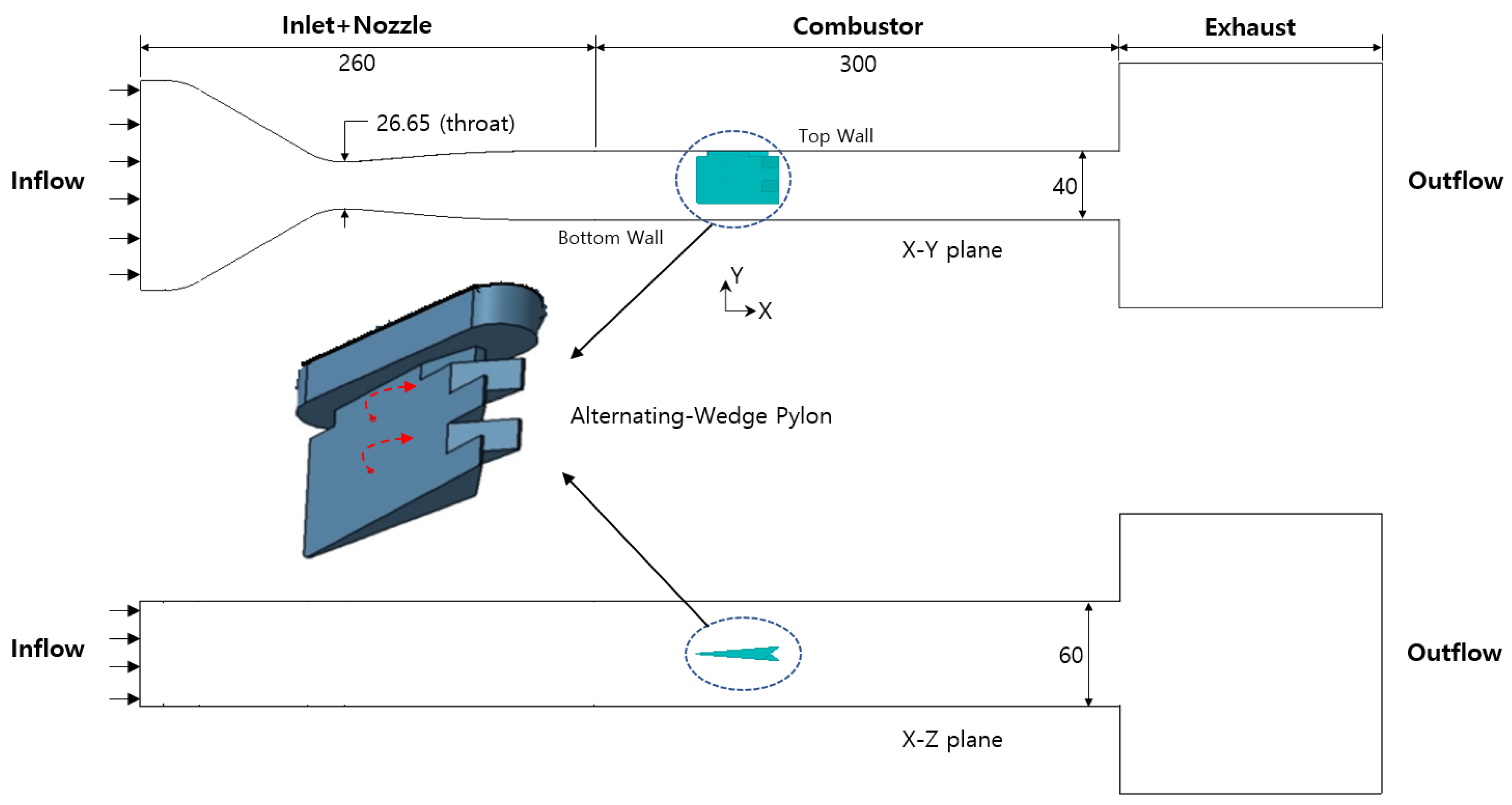
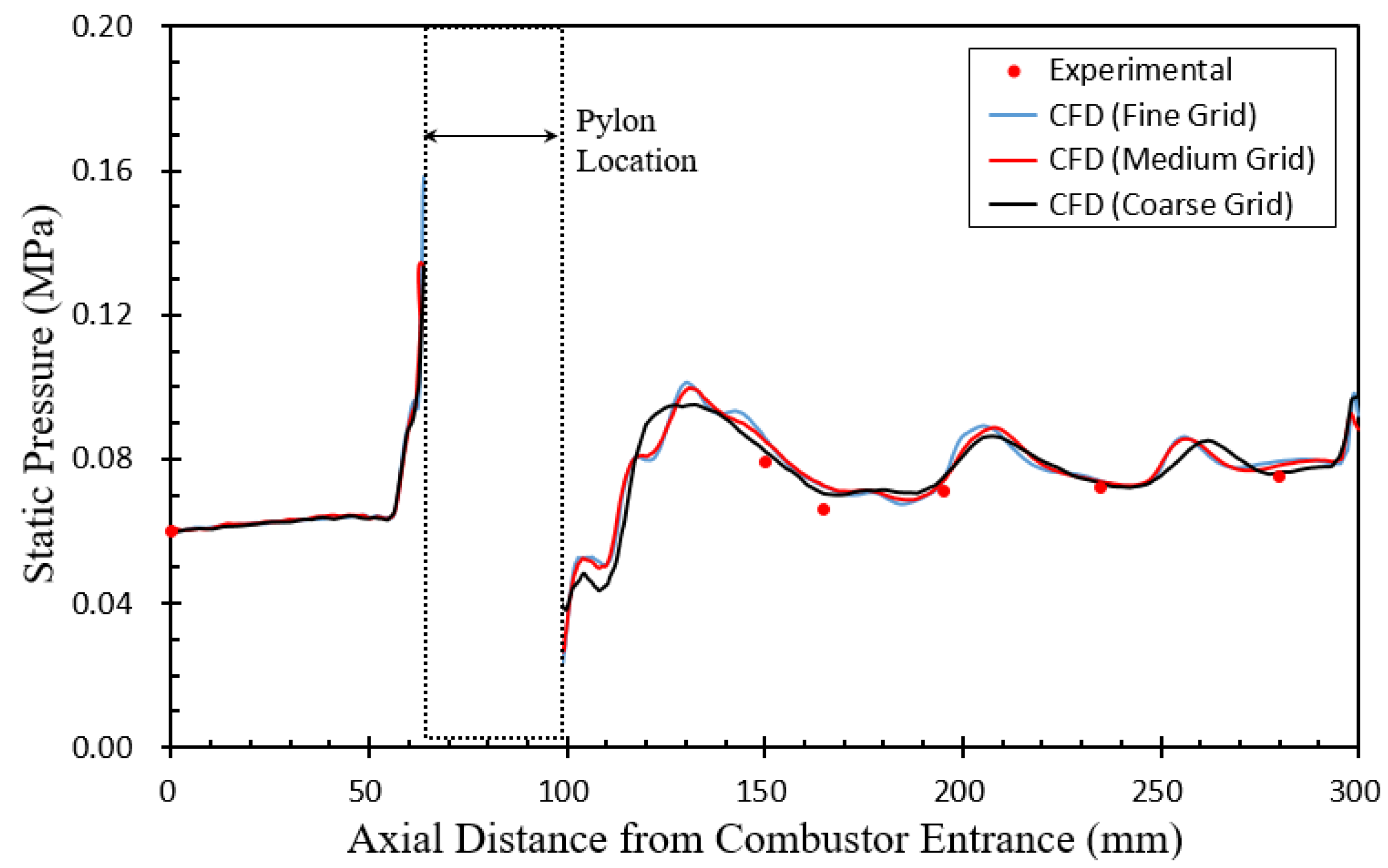
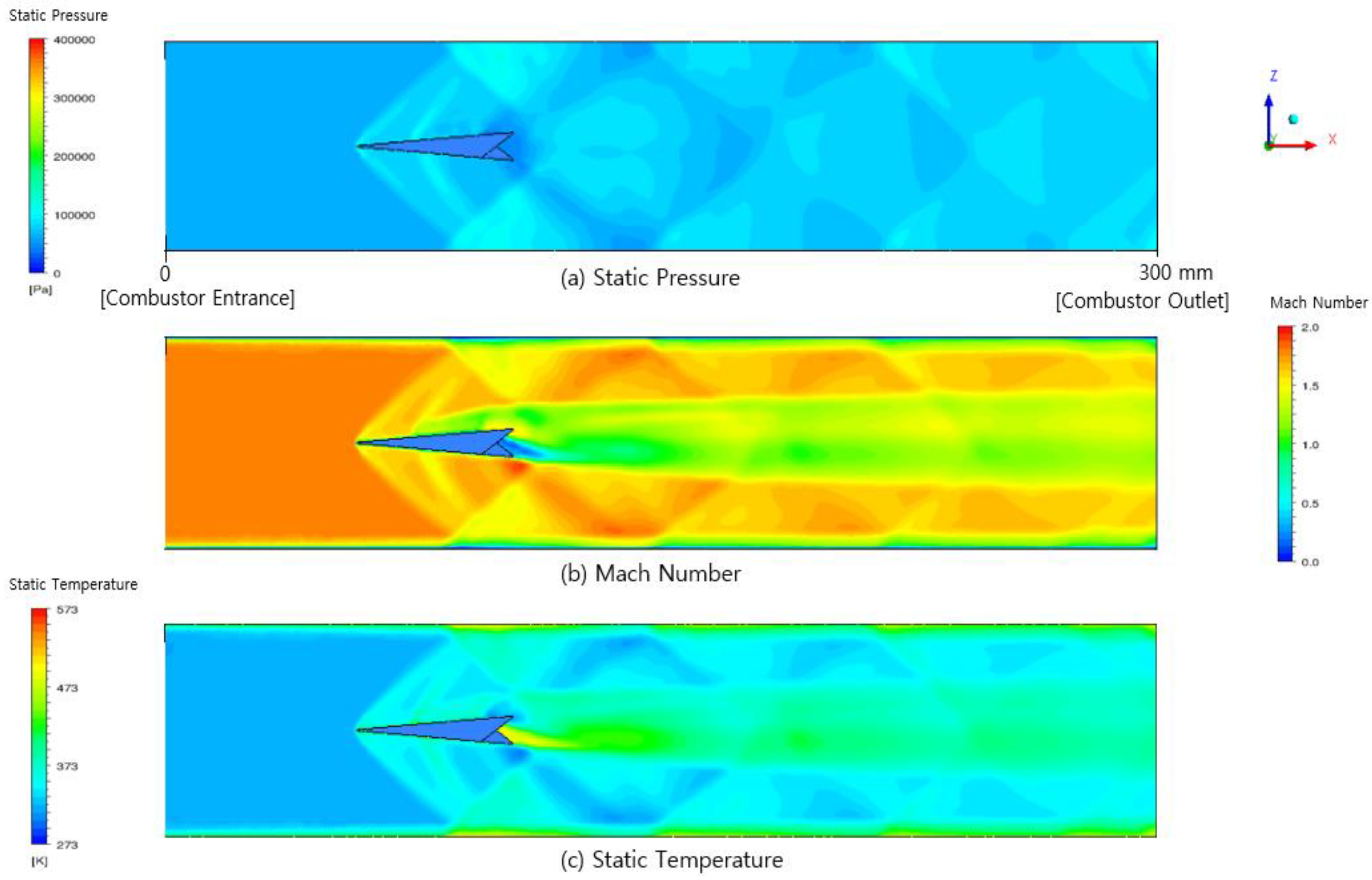
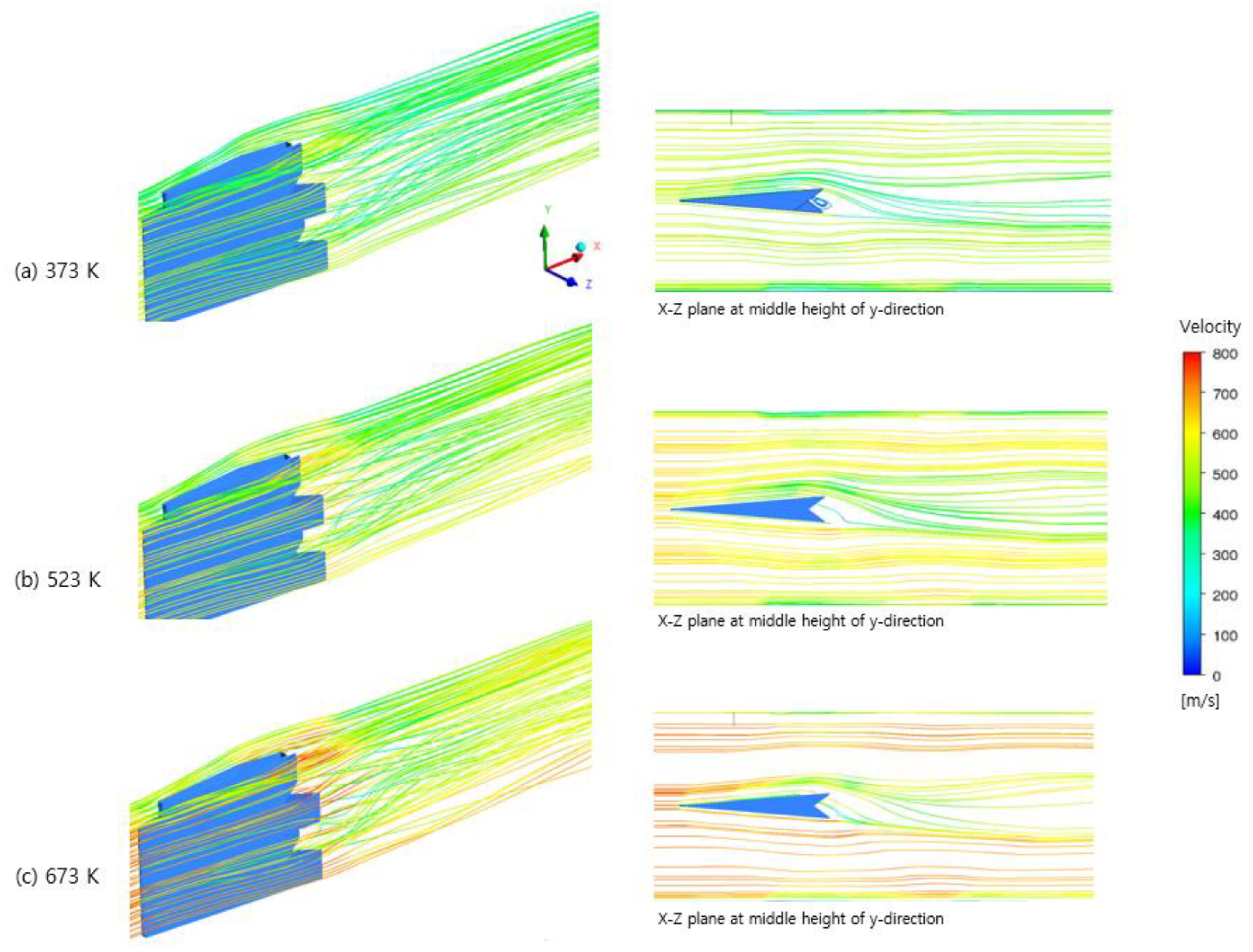
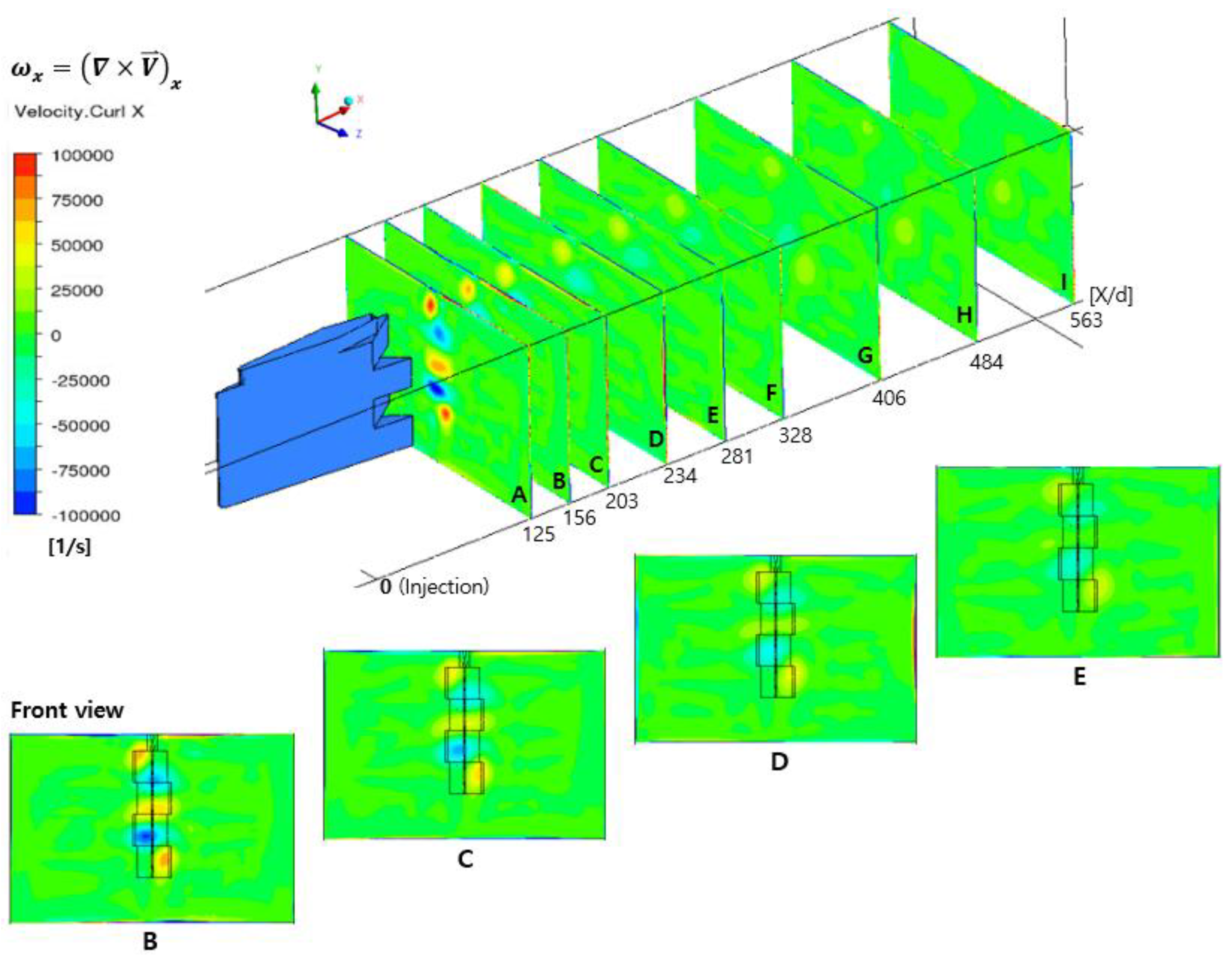
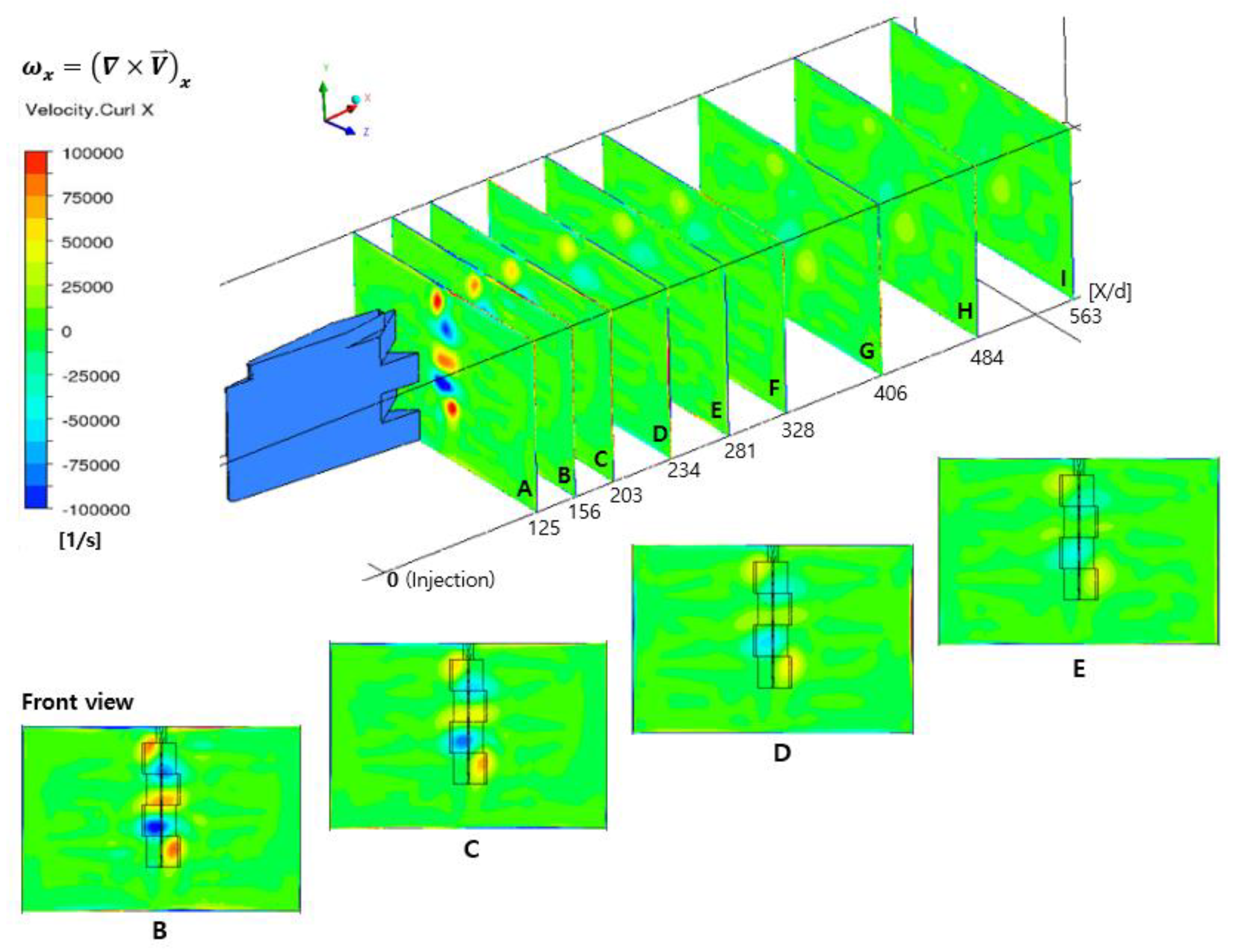
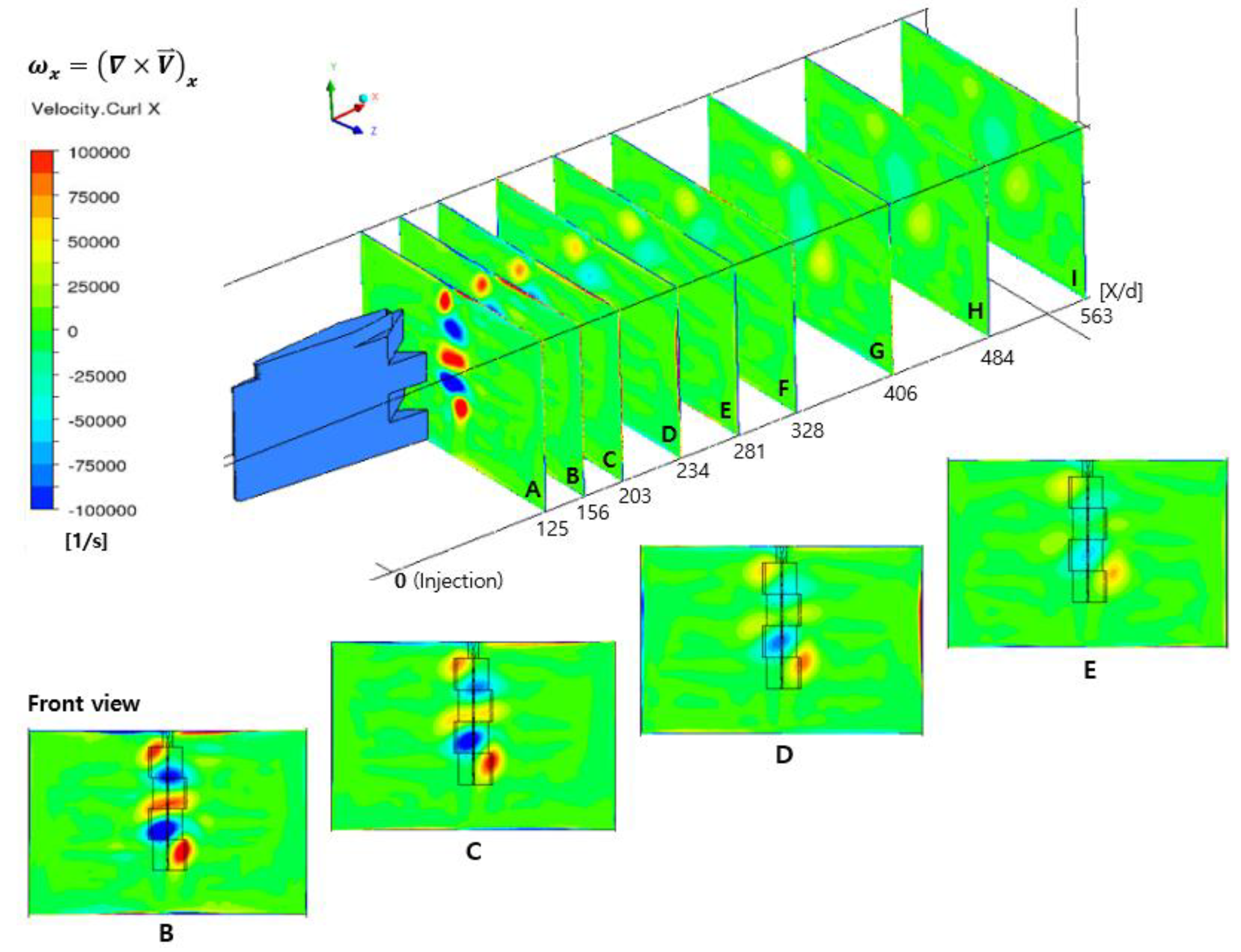
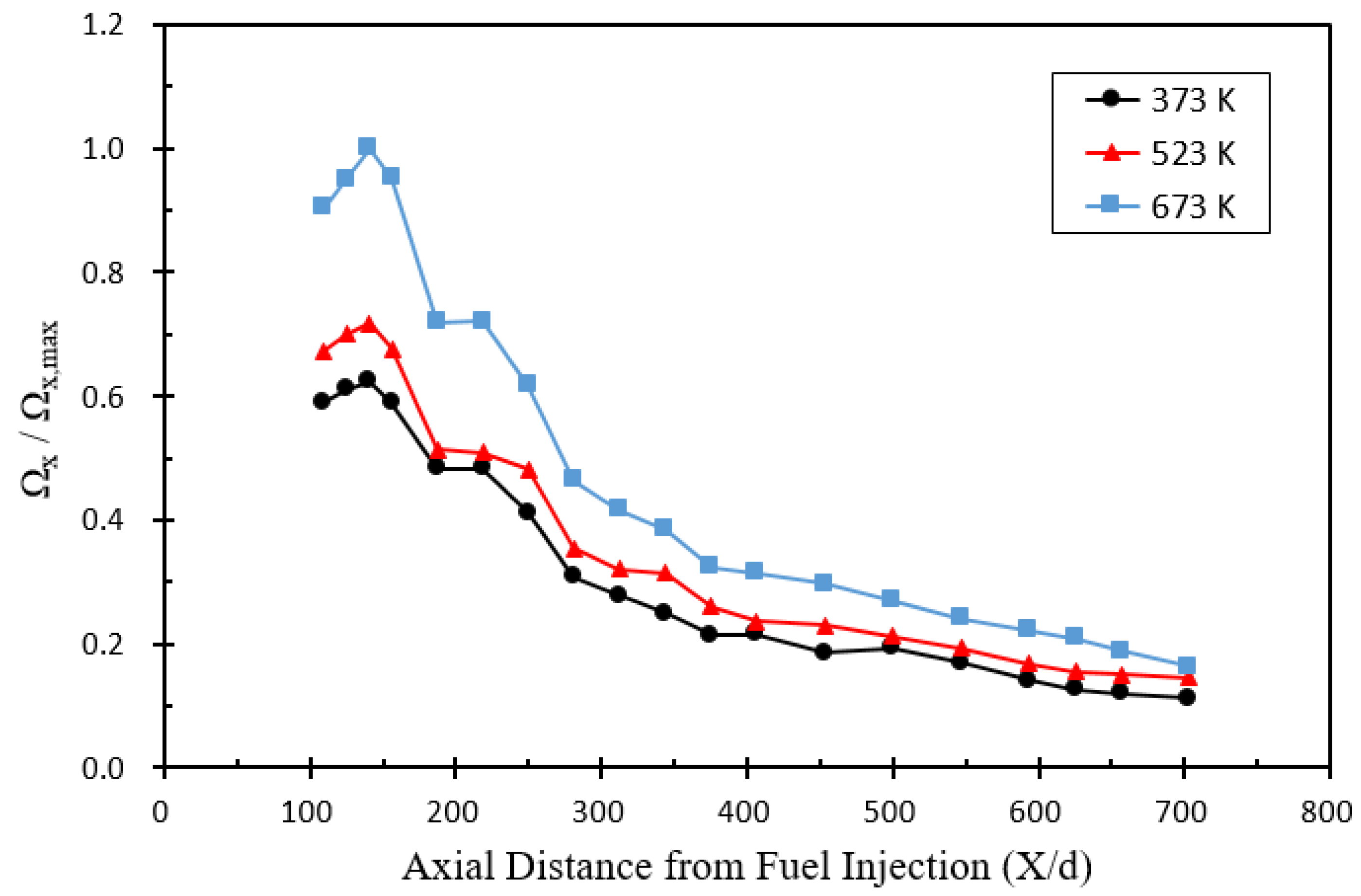

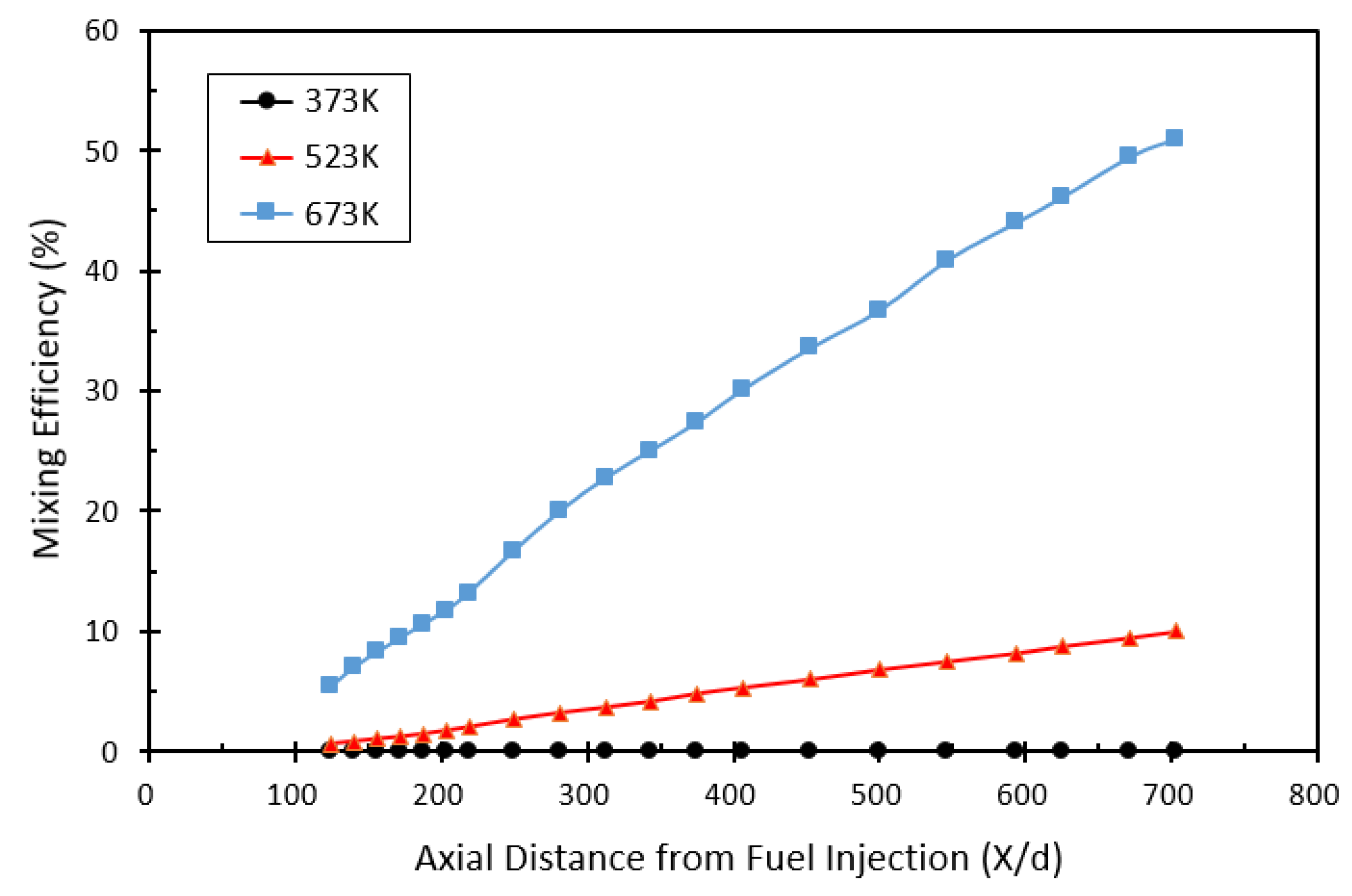
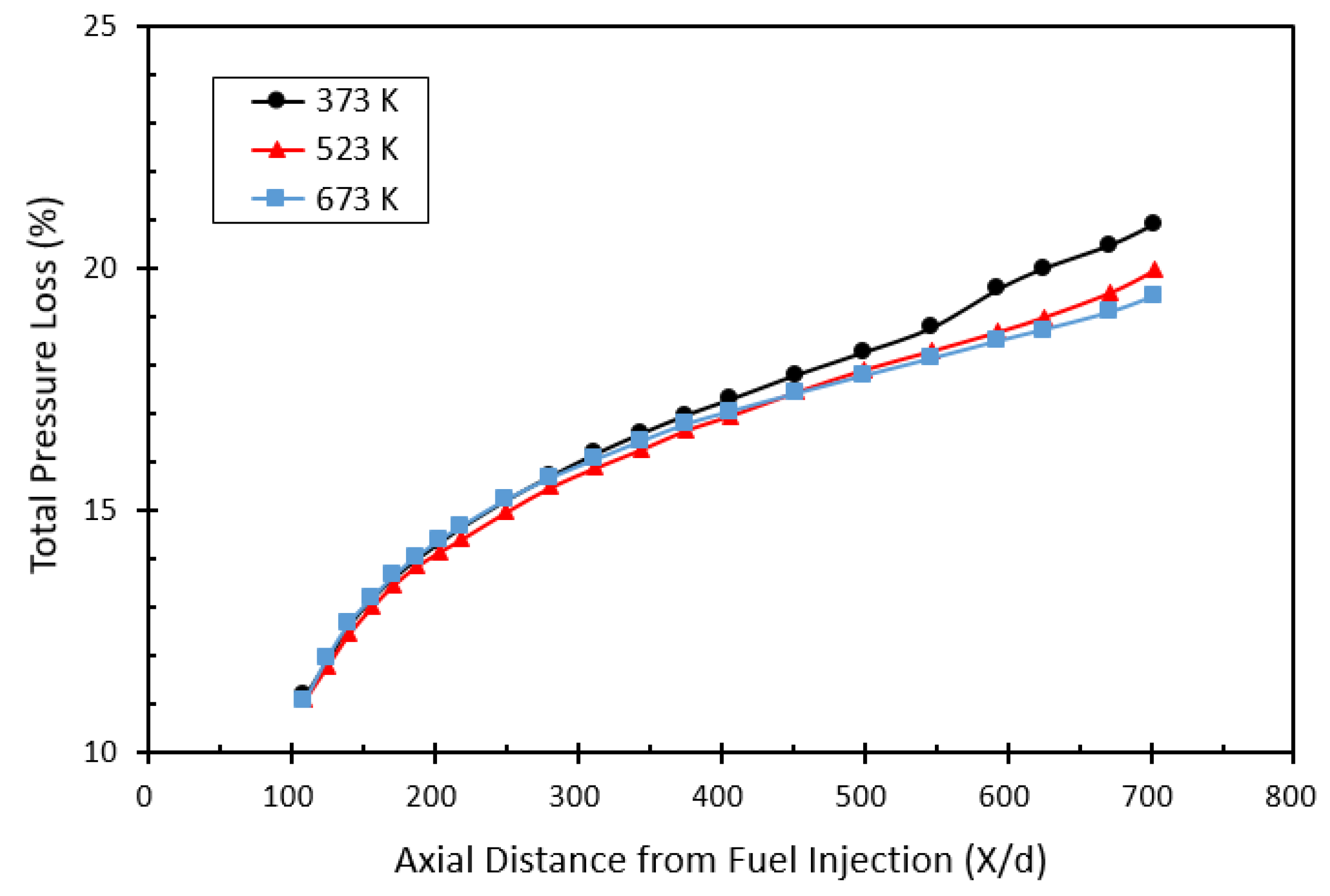
Disclaimer/Publisher’s Note: The statements, opinions and data contained in all publications are solely those of the individual author(s) and contributor(s) and not of MDPI and/or the editor(s). MDPI and/or the editor(s) disclaim responsibility for any injury to people or property resulting from any ideas, methods, instructions or products referred to in the content. |
© 2023 by the authors. Licensee MDPI, Basel, Switzerland. This article is an open access article distributed under the terms and conditions of the Creative Commons Attribution (CC BY) license (https://creativecommons.org/licenses/by/4.0/).
Share and Cite
Hwang, B.-J.; Min, S. Numerical Investigation of the Effect of Supersonic Air Temperature on the Mixing Characteristics of Liquid Fuel. Energies 2023, 16, 496. https://doi.org/10.3390/en16010496
Hwang B-J, Min S. Numerical Investigation of the Effect of Supersonic Air Temperature on the Mixing Characteristics of Liquid Fuel. Energies. 2023; 16(1):496. https://doi.org/10.3390/en16010496
Chicago/Turabian StyleHwang, Byeong-Jo, and Seongki Min. 2023. "Numerical Investigation of the Effect of Supersonic Air Temperature on the Mixing Characteristics of Liquid Fuel" Energies 16, no. 1: 496. https://doi.org/10.3390/en16010496
APA StyleHwang, B.-J., & Min, S. (2023). Numerical Investigation of the Effect of Supersonic Air Temperature on the Mixing Characteristics of Liquid Fuel. Energies, 16(1), 496. https://doi.org/10.3390/en16010496




